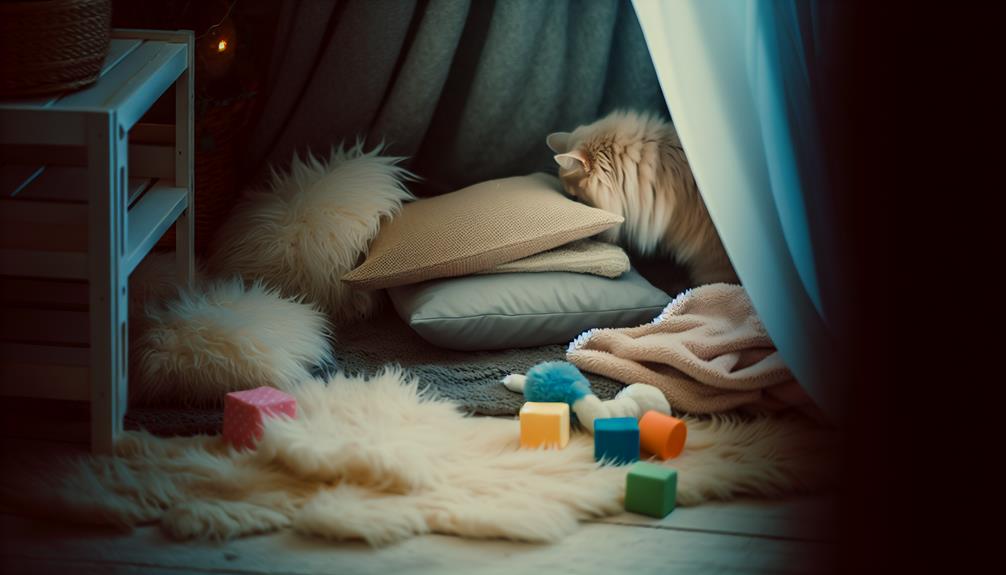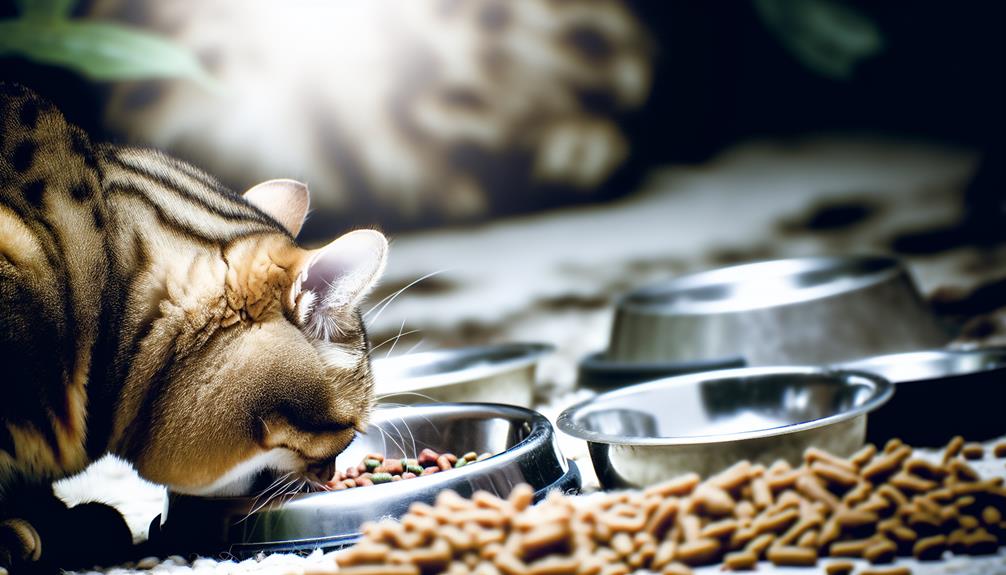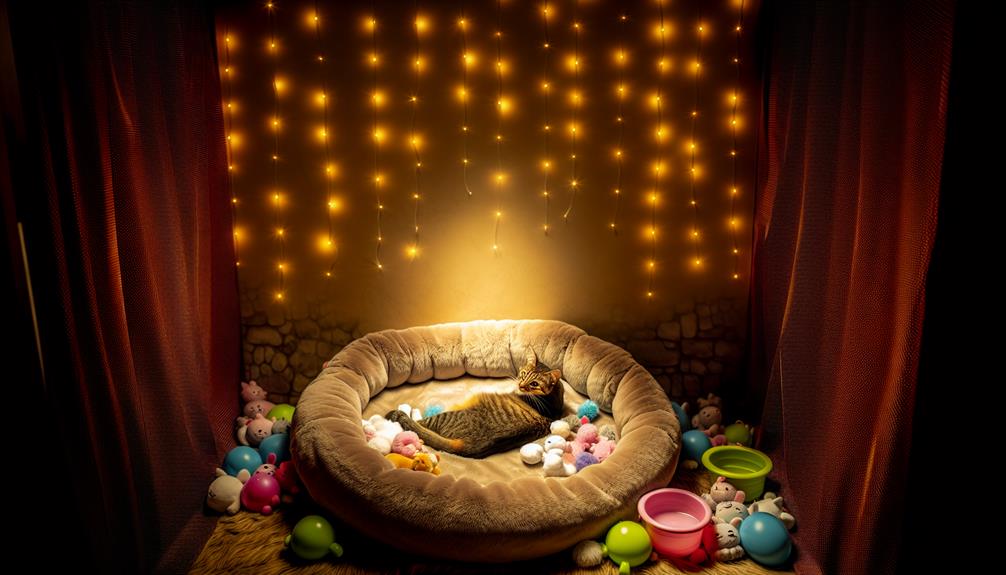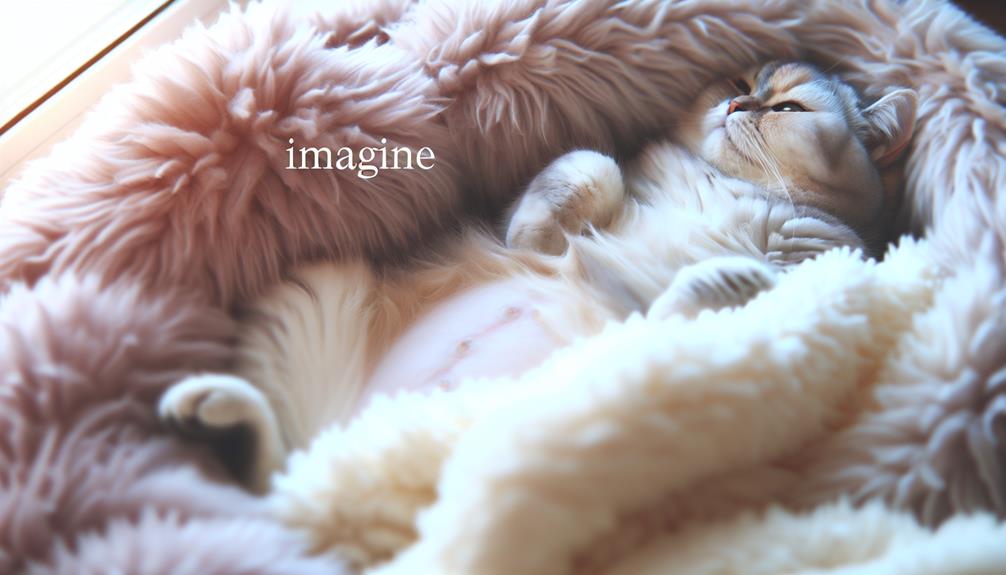When your cat, like Bella, begins to show unusual mood swings and increased affection, you might start wondering if she's pregnant. You'll also notice physical signs such as her nipples becoming swollen or her abdomen enlarging. But that's not all. There are behavioral changes like nesting instincts where she might start digging or appearing restless. To be sure, a vet visit is essential, as they can confirm the pregnancy through methods like ultrasound. Curious about other signs and what you should do next to prepare for the kittens?
Behavioral Changes
When observing your cat for signs of pregnancy, one of the earliest indicators may be behavioral changes. You might notice your cat exhibiting mood swings, which can manifest as a shift between periods of affection and aloofness. These mood swings are often a result of hormonal fluctuations that occur during pregnancy.
In addition to mood swings, social changes are another significant behavioral indicator. A pregnant cat may become more affectionate, seeking more attention from you, or conversely, she might become more withdrawn and prefer solitude. This variability in social behavior can be perplexing, but it's a common aspect of feline pregnancy.
You should also pay attention to your cat's nesting behavior. Pregnant cats often start searching for quiet, comfortable places to give birth. This nesting instinct can lead her to explore closets, under beds, or other secluded spots in your home.
Furthermore, increased vocalization can occur. Your cat might meow more frequently or exhibit different vocal patterns, another possible sign of pregnancy-related stress or discomfort.
Monitoring these behaviors closely is essential. Keep a detailed record of any noticeable changes in your cat's behavior. This log can be invaluable when consulting with your veterinarian for a definitive diagnosis.
Physical Signs
When evaluating a cat for pregnancy, look for an enlarged abdomen, which indicates fetal growth. Swollen nipples, or "pinking up," and a noticeable weight gain are also key physical signs. These indicators, combined with behavioral changes, strengthen the likelihood of a positive diagnosis.
Enlarged Abdomen
One of the most noticeable physical signs indicating that a cat might be pregnant is an enlarged abdomen. This sign usually becomes evident around the halfway point of the feline gestation timeline, which typically spans approximately 63-65 days. By the third to fourth week, you might observe a gradual, symmetrical distension of your cat's abdomen.
To confirm pregnancy, veterinary professionals often perform an abdominal palpation. This diagnostic technique involves gently feeling the cat's abdomen to detect the presence of developing fetuses. During this procedure, a skilled practitioner can identify the small, marble-like structures within the uterus. It's essential to have this performed by a veterinarian to avoid causing harm to the cat or the fetuses.
As the pregnancy progresses, the enlarged abdomen will become more pronounced, especially in the final stages of gestation. If you observe this symptom, it's advisable to seek veterinary consultation to confirm pregnancy and monitor the health of both the mother and her developing kittens. Additionally, your veterinarian may use other diagnostic tools like ultrasound or radiography to provide a more thorough assessment of the pregnancy status and fetal development.
Swollen Nipples
Even before an enlarged abdomen becomes apparent, another early indicator of feline pregnancy is the presence of swollen nipples. This condition, medically termed "pinkening," typically manifests around the third week of gestation. The swollen nipple causes stem from hormonal changes that prepare the cat's body for nursing. Specifically, elevated levels of progesterone and estrogen lead to increased blood flow, resulting in both enlargement and a distinct pink or reddish hue of the nipples.
To accurately diagnose pregnancy through this sign, you'll need to perform a gentle examination. Carefully observe each of the cat's eight nipples for consistent swelling and color change. Be mindful that false pregnancy, or pseudopregnancy, can sometimes cause similar physical changes. As a result, corroborating this symptom with other indicators is vital for a definitive diagnosis.
Regarding nipple care, maintaining hygiene is key. Swollen nipples are more susceptible to irritation and potential infections, such as mastitis. Make sure that the cat's environment is clean, and avoid any rough handling of the area. If you notice excessive redness, discharge, or if the cat appears to be in discomfort, consult a veterinarian promptly to rule out complications.
Weight Gain
As the pregnancy progresses, you'll likely notice significant weight gain in your cat. This weight gain is a vital indicator of a healthy pregnancy and is typically due to the growth of the kittens and an increase in the cat's body fat reserves. Monitoring your cat's weight is important for effective weight management during this period.
To accurately assess weight gain, you should weigh your cat regularly using a precise scale. Record her weight weekly to track any significant changes. A steady increase of about one to two pounds over the course of the pregnancy is typical, but this can vary depending on the number of kittens and the individual cat's baseline weight.
Your cat's nutritional needs will also change as she progresses through pregnancy. Make sure she receives a balanced diet rich in proteins and essential nutrients to support fetal development and maintain her health. Consult your veterinarian for dietary recommendations tailored to your cat's specific needs. They may suggest a specially formulated kitten food that provides higher levels of protein and energy.
Early and consistent attention to weight management and nutritional needs will help promote a healthy pregnancy for your cat and her kittens.
Nesting Instincts

When observing nesting instincts, you'll notice your cat exhibiting increased restlessness as she searches for a secure environment. This behavior includes creating cozy spaces, such as rearranging bedding or finding secluded areas. Monitoring these activities can help you confirm pregnancy and anticipate the birthing process.
Increased Restlessness
One of the telltale signs that might give away your cat's pregnancy is increased restlessness, often manifesting as nesting instincts. As your cat progresses through gestation, you might notice an uptick in her activity levels. This restless behavior is typically linked to her instinctual drive to prepare a safe and comfortable environment for her impending litter. Diagnostically, increased restlessness can be characterized by several observable behaviors.
Here are three key indicators to watch for:
- Frequent Movement: Your cat may exhibit increased activity, wandering from room to room or frequently shifting positions, seemingly unable to settle down.
- Persistent Scratching or Digging: She might engage in more pronounced scratching or digging, particularly in areas where she might later decide to nest, such as bedding, closets, or quiet corners.
- Vocalization: Increased vocalization can be another sign, as she communicates her discomfort or the need to find a suitable nesting spot.
Clinically, observing these behaviors can be instrumental in confirming pregnancy alongside other diagnostic methods like palpation or ultrasound. Monitoring your cat's increased restlessness and nesting instincts provides valuable insights into her reproductive status and helps guarantee you're prepared for the arrival of kittens.
Creating Cozy Spaces
To facilitate your pregnant cat's nesting instincts, creating cozy spaces is paramount. Nesting behavior typically emerges in the latter stages of gestation, signaling your cat's preparation for birthing. Ensuring a safe environment is critical, as your feline will seek out secluded and tranquil areas. Utilize comforting materials such as soft blankets, towels, or cushioned bedding to provide the tactile comfort she craves.
Your designated nesting area should be in a low-traffic, quiet part of your home. Here's a guide to help you set up ideal nesting spaces:
| Factor | Description |
|---|---|
| Location | Low-traffic, quiet, away from household noise |
| Material | Soft blankets, towels, cushioned bedding |
| Accessibility | Easy for your cat to enter and exit |
| Safety | Free from sharp objects, toxic substances |
The nesting site should be easily accessible but shielded from potential disturbances, ensuring your cat feels secure. Regularly inspect and replace any soiled or damaged materials, maintaining a clean and hygienic space. Monitoring your cat's preferences and adjustments can provide insight into her comfort levels, ensuring a smooth shift to motherhood. Prioritize creating a refuge where she can retreat, thereby fostering her maternal instincts and promoting her overall well-being.
Weight Gain
Weight gain is a notable indicator of feline pregnancy and is often one of the earliest signs noticed. Monitoring your cat's weight is vital for identifying pregnancy early and guaranteeing appropriate prenatal care. Weight gain in a pregnant cat generally starts to become noticeable around the second to third week of gestation.
To accurately track weight gain, you should utilize a consistent method of weighing your cat. Here's a systematic approach:
- Baseline Weight: Weigh your cat before any signs of pregnancy or as soon as you suspect she might be pregnant. This establishes a baseline for comparison.
- Weekly Weigh-ins: Conduct weekly weigh-ins using a digital pet scale. Consistency is key, so try to weigh her at the same time each day.
- Record Keeping: Maintain a log of the weekly weights. A noticeable and steady increase in weight, typically between 1 to 2 pounds over the course of the pregnancy, is a strong indicator of gestation.
Understanding cat nutrition during this period is essential. Your cat's nutritional needs will change as she progresses through her pregnancy. High-quality, nutrient-dense food formulated for pregnant cats can help guarantee she gains weight healthily. Adequate nutrition supports fetal development and prepares your cat for the demands of nursing.
Moreover, consulting your veterinarian for tailored prenatal care advice can greatly benefit both the queen and her developing kittens. Regular veterinary check-ups can help monitor weight gain and overall health, guaranteeing any complications are addressed promptly.
Appetite Increase

A sudden surge in your cat's appetite can serve as a vital diagnostic indicator of pregnancy. As a cat's body prepares to support the growth of fetuses, it demands more nutrients and energy, leading to noticeable appetite changes. You might observe that your cat is eating larger portions or requesting food more frequently. This is a natural response, as the metabolic demands during pregnancy increase considerably.
The physiological basis for this increase lies in the hormonal changes that accompany feline pregnancy. Elevated levels of progesterone and other gestational hormones stimulate your cat's appetite to guarantee adequate caloric intake. This is fundamental for both the mother's health and the development of the unborn kittens. As a result, monitoring your cat's feeding frequency can provide valuable insights into her reproductive status.
When evaluating appetite changes as a potential sign of pregnancy, it's important to establish a baseline. Keep track of your cat's normal eating habits before suspecting pregnancy. Once you've established this baseline, any deviations—such as increased feeding frequency or an uncharacteristic urgency for food—become more apparent and diagnostically important.
However, appetite increases can also be symptomatic of other conditions, such as hyperthyroidism or diabetes. Hence, it's important not to rely solely on this indicator. In a clinical setting, a thorough approach is recommended. Document any accompanying signs, such as weight gain or behavioral changes, to build a holistic view of your cat's health.
Vet Confirmation
Confirming a cat's pregnancy with certainty often necessitates veterinary intervention. While behavioral and physical signs may hint at pregnancy, definitive diagnosis requires professional evaluation. A veterinarian has several diagnostic tools at their disposal, guaranteeing an accurate and reliable confirmation.
- Ultrasound Examination: This is typically the preferred method for early pregnancy detection. An ultrasound can usually detect fetal heartbeats as early as 3 weeks into gestation. The procedure is non-invasive and provides real-time images of the developing embryos, allowing the vet to assess the number of kittens and their viability.
- Palpation: Around the 20th to 30th day of pregnancy, a skilled veterinarian can sometimes feel the developing fetuses through gentle abdominal palpation. However, this method requires significant expertise to avoid causing harm and is less reliable than other diagnostic tools.
- Hormone Testing: Another approach involves measuring the levels of the hormone relaxin in the cat's blood. Relaxin is produced by the developing placenta and can be detected around 25 to 30 days into the pregnancy. While effective, this method is less commonly employed than ultrasound due to the need for blood sampling and laboratory analysis.
Each diagnostic method has its advantages and limitations, but combining them can provide a thorough assessment. It's essential to consult with your veterinarian to determine the most appropriate approach based on your cat's specific circumstances. By utilizing these diagnostic techniques, you can assure both the cat's health and the successful progression of her pregnancy.
Preparing for Kittens

Once your veterinarian has confirmed the pregnancy, it's time to start preparing for the arrival of the kittens. The first step in guaranteeing a smooth birthing process and immediate postnatal kitten care is to provide your cat with a safe environment. Choose a quiet, low-traffic area in your home where your cat can feel secure. A large box or a specialized birthing bed lined with soft, clean blankets serves as an ideal nesting space.
Monitor your cat's nutritional intake, as pregnant cats require an increased caloric intake. High-quality kitten food, rich in essential nutrients, is recommended to support both the mother and her developing kittens. Make sure fresh water is always available, as hydration is essential.
Regular veterinary checkups are important during your cat's pregnancy. These visits allow for the monitoring of the cat's health and the development of the kittens. Your vet might perform ultrasounds or radiographs to assess the number and positioning of the kittens, which can aid in anticipating any complications during delivery.
As the due date approaches, it's important to familiarize yourself with the stages of labor and signs of potential complications. Common indicators that labor is imminent include nesting behavior, restlessness, and a drop in body temperature. Keep your veterinarian's contact information readily available in case of emergencies.
Post-birth, focus on initial kitten care. Make sure each kitten is breathing and nursing. If a kitten appears weak or isn't nursing, consult your veterinarian immediately. Maintaining a clean, warm environment is critical for the health and development of the newborn kittens.
Conclusion
In summary, recognizing a pregnant cat involves observing behavioral changes, physical signs, and nesting instincts. Weight gain and increased appetite also serve as indicators. For definitive confirmation, a veterinarian's expertise is indispensable, employing diagnostic tools like ultrasounds and palpation. It's essential to prepare a safe, comfortable space for your expecting feline. Like a detective piecing together clues, these observations will guide you in ensuring your cat's pregnancy is healthy and well-managed.
